
Are consumers already living the future of health? Key trends in agency, virtual health, remote monitoring, and data-sharing
15 minute read
13 August 2020
Pandemic-accelerated trends in consumer behavior have the potential to transform various aspects of the health care system. How can organizations meet consumers’ changing needs and move toward the future of health?
Executive summary
The COVID-19 pandemic has turned the health care system upside down and challenged consumers’ sense of well-being. In many ways consumers are taking charge of their health more than ever before. They are learning about their health risks, communicating with their doctors in new and different ways, and changing their attitudes about data privacy. Each of these factors has a significant influence on how consumers are feeling and interacting with the health system. Going forward, how will these events and factors change consumer behavior? Are we more or less likely to see empowered health care consumers?
Learn more
Explore the Health care collection
This article is featured in Deloitte Insights Magazine
Learn about Deloitte’s services
Go straight to smart. Get the Deloitte Insights app
We gained an understanding of current US consumer behaviors and attitudes through the 2020 Deloitte Center for Health Solutions’ biennial survey (the Deloitte 2020 Survey of US Health Care Consumers). Since 2008, Deloitte has been conducting this survey to explore and collect longitudinal data on the subject, and this year we rolled it out just before the pandemic started. We also collected insights from a consumer survey during the pandemic (in April and early May 2020)—The Health Care Consumer Response to COVID-19 Survey.
Findings show that:
- Many consumers show agency and engagement: Consumers are increasingly willing to tell their doctors when they disagree with them, are using tools to get information on costs and health issues, are tracking their health conditions and using that data to make decisions, and accessing and using their medical record data.
- Consumers are using virtual visits more than ever before and plan to continue using them: Consumers using virtual visits rose from 15% to 19% from 2019 to early 2020; this jumped to 28% in April 2020. On average, 80% are likely to have another virtual visit, even post COVID-19. Most consumers are satisfied with their visits and say they will use this type of care again.
- More consumers are using technology for health monitoring and are willing to share their data: A growing number of consumers are using technology to monitor their health, measure fitness, and order prescription-drug refills. After a slight decline in willingness to share data before COVID-19, new data shows that consumers are more comfortable sharing data during a crisis.
- A trusted clinician relationship remains paramount: The top factors for “an ideal health care experience” in the Deloitte 2020 Survey of US Health Care Consumers mirrored the findings of a similar study in 2016: doctors who listen to/care about them, doctors who don’t rush, and clear communication. As health systems, technology companies, and others roll out virtual services, it is imperative to provide the same personal experience as during an in-person visit. This is particularly true for organizations that are developing tools or services for those with chronic conditions, as they are most likely to value a sustained relationship.
The pandemic has accelerated consumer activation in some respects and slowed it down in others. On the one hand, patients are increasing virtual visits, interactions with health technology, and are more willing to share data. On the other hand, people are reporting increased levels of anxiety, financial and economic worries, and hesitation to go outside and get back to “everyday life” for fear of getting the virus or passing it along to others.
During this time of great uncertainty for consumers, health care organizations should recommit themselves to understanding consumers and creating a multifaceted strategy that speaks to where consumers are right now.
The consumer in the future of health
Deloitte’s future of health vision for 2040 has the consumer at the center. Over time, we’ve seen increases in consumer agency and activation, which drive many of the underlying trends. But the pandemic’s widespread impacts on the health care system and consumer are bringing into clearer focus aspects of our vision for the future of health. Harder-to-imagine ideas about the ways in which consumers will engage in their health in the future proved to be realistic by the changes forced on the system by the pandemic. The public health crisis has called on the system to provide consumers access to care from home, and in some ways, encourage consumers to have more agency in making decisions about their health. We anticipate that as the crisis abates, consumers will continue to expect the conveniences and tools to which they have become accustomed during this time.
How the pandemic has affected pre-COVID consumer trends
The COVID-19 pandemic has significantly changed consumer behaviors and attitudes along with their anxiety and comfort levels about health care globally. To gain insights into this shift, we examined both longitudinal data prior to the COVID-19 pandemic and survey responses during the pandemic.
Specifically, we used the Deloitte Center for Health Solutions’ biennial survey (the Deloitte 2020 Survey of US Health Care Consumers), which we have been using since 2008 to explore and collect longitudinal data on the subject. This year we surveyed 4,522 consumers between February 24 and March 14, 2020, just before COVID-19 became widespread and before governments put social-distancing restrictions in place. Deloitte also fielded another consumer survey during the pandemic; the Health Care Consumer Response to COVID-19 Survey surveyed 1,510 American consumers about their health, experiences, and behavior in mid-April to early May 2020.(For more details on the methodology, see the sidebar “Inside the Deloitte consumer surveys”).
Inside the Deloitte consumer surveys
- 2020 Survey of US Health Care Consumers: Since 2008, the Deloitte Center for Health Solutions (DCHS) has surveyed a nationally representative sample of US adults (18 and older) about their experiences and attitudes related to their health, health insurance, and health care in general. The national sample is representative of the US census with respect to age, gender, race/ethnicity, income, geography, and insurance source. As part of this effort, from February 24 through March 14, 2020, DCHS conducted an online survey of 4,522 US adults.
- Health Care Consumer Response to COVID-19 Survey: In April—during the peak of the COVID-19 crisis—Deloitte surveyed 1,510 health care consumers to understand the emotional toll of the pandemic and how their attitudes and behavior in managing their health and well-being are changing.
In this paper we first explore the period before and up to the eve of the pandemic. Next, we examine how the changes in health care delivery and consumer experiences during the pandemic have changed the consumer, in the short and, potentially, the long term. We also look into the implications of the findings on how health care organizations relate to consumers going forward.
What the survey results say
Consumers are becoming increasingly active and engaged in their health care
In our vision for the future we see a more activated consumer whose attitudes and behavior demonstrate agency. We measured and explored several aspects of consumer agency in health care:
- Willingness to disagree with their doctor
- Tracking their health conditions and using that data to make decisions
- Accessing and using their medical record data and wanting ownership of it
- Engaging in healthy behavior/prevention
In early 2020, 51% of consumers said they were very or extremely likely to tell their doctors when they disagree with them (figure 1). More than half of seniors and boomers are likely to be vocal about their disagreement vs half/less than half of younger generations—63% of seniors and 57% of boomers vs 50% of Gen X and 46% of millennials and Gen Z).
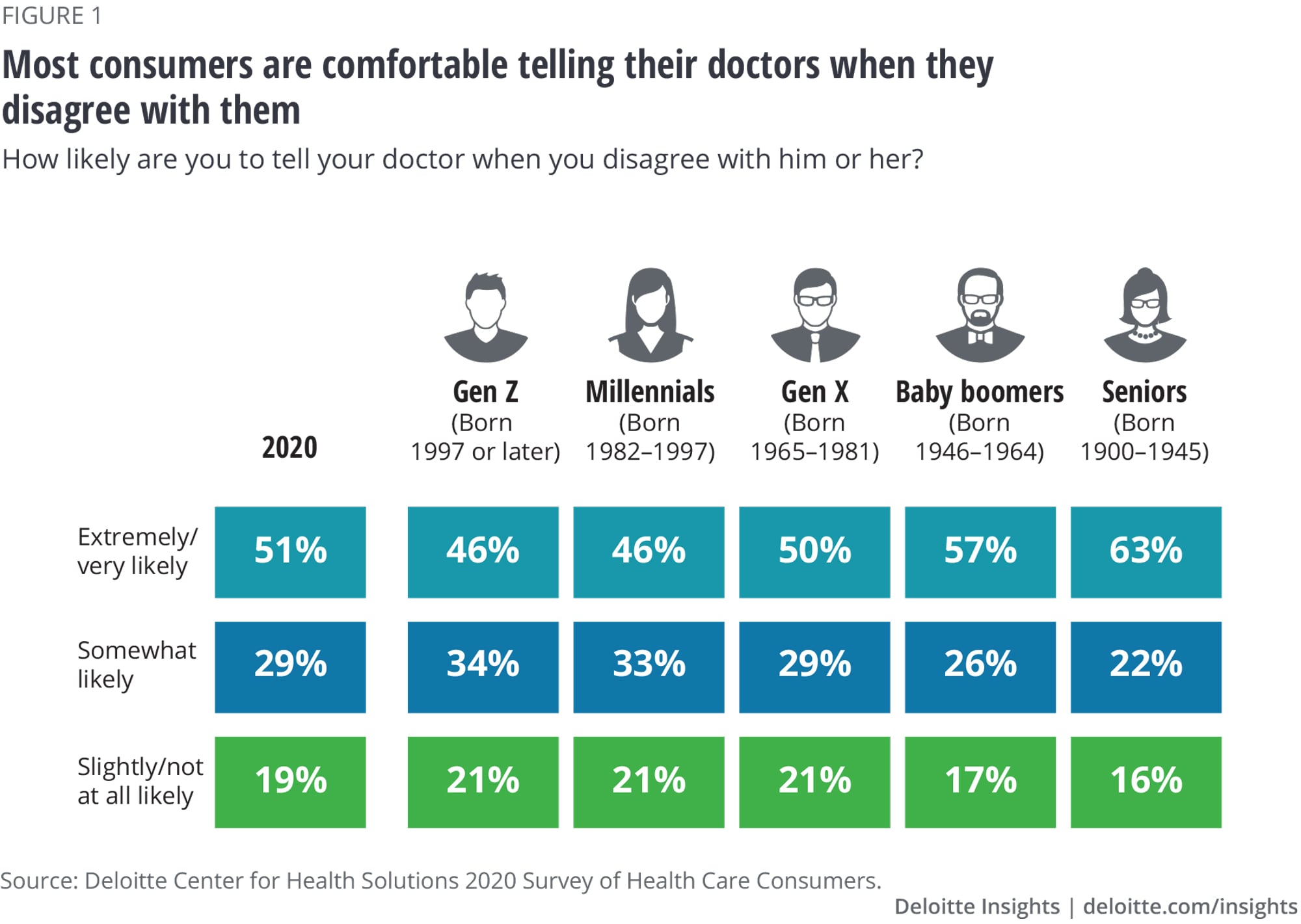
Consumers are increasingly using technology and apps to measure and maintain their health
In 2020, 42% of US consumers said they used tools to measure fitness and track health-improvement goals. Though this has stayed the same since 2018, it’s a significant jump from just 17% in 2013.
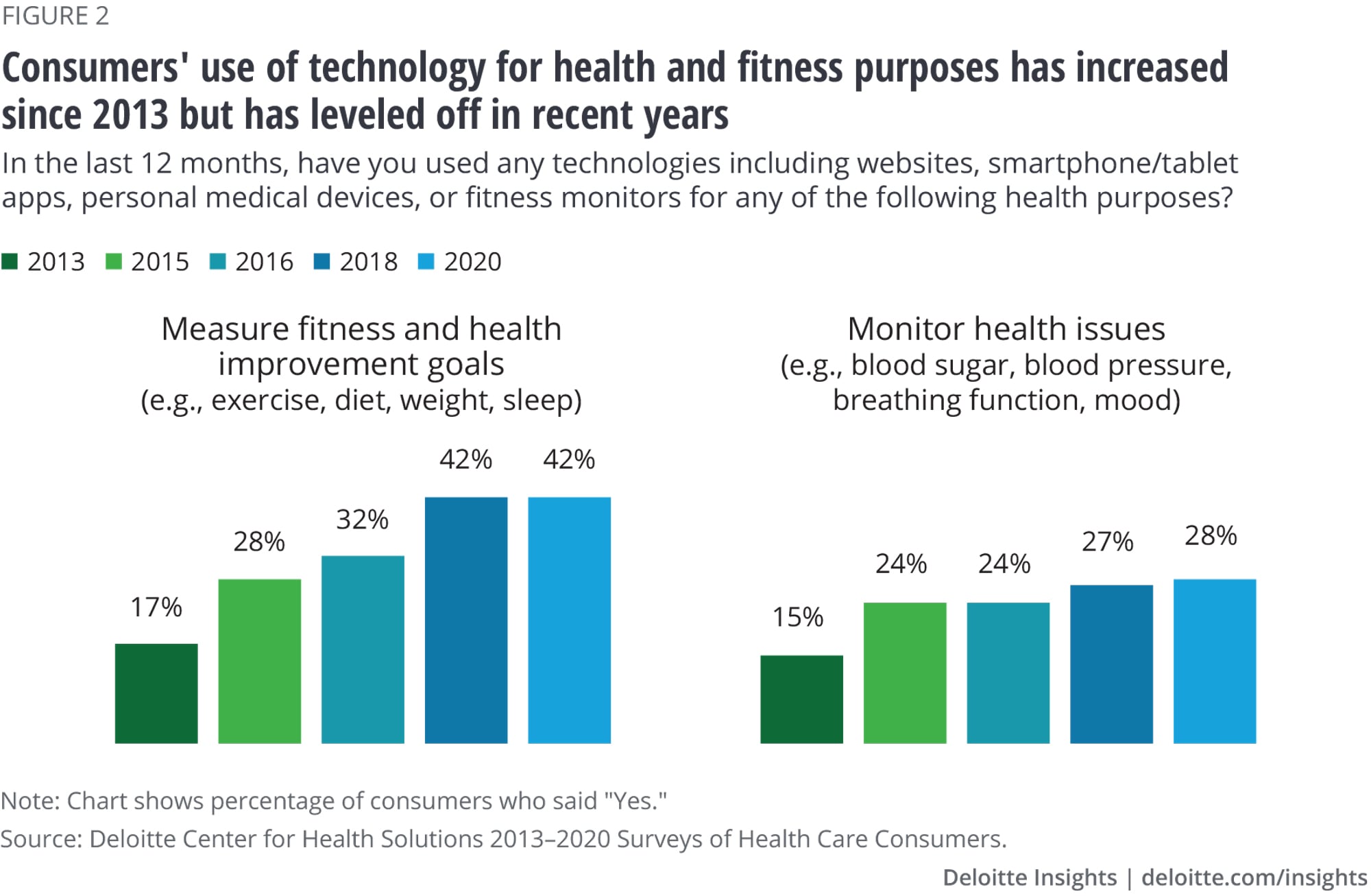
In 2020, among those who used a fitness device or a monitoring device, about half shared data from it with their doctor. Those in excellent health (62%) and those with difficult chronic diseases (75%) are most likely to share their information with their doctor.
Consumers believe that devices help them change their behavior
Among individuals who track their health, 77% say it changes their behavior at least moderately (figure 3). Younger generations (Gen Z and millennials) are much more likely to say it changes their behavior.
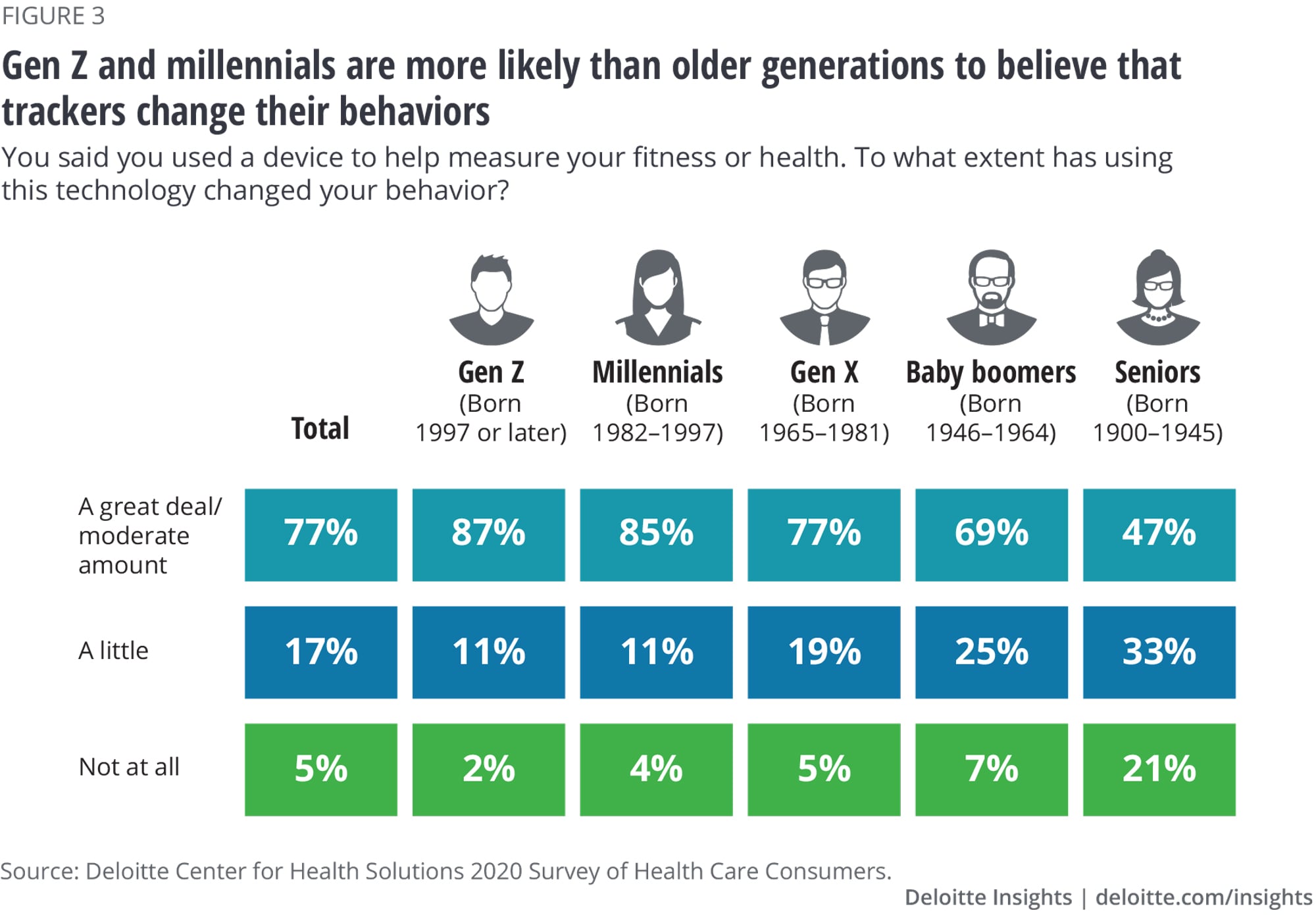
The pandemic has changed consumers’ wellness behaviors and how they feel about and access health care
The pandemic has changed the way many consumers are interacting with the health care system. It has accelerated consumer activation in some respects and slowed it down in others. On the one hand, consumers have increased virtual visits and interactions with health technology and are more willing to share their personal data. On the other hand, many individuals are reporting increased levels of anxiety, financial and economic worries, increased purchasing of processed foods, and hesitation to go outside and get back to “everyday life” for fear of getting the virus or passing it along to others.
We found that in early 2020 many consumers reported engaging in prevention and healthy behavior, but some initial evidence is showing that this has increased for some but has decreased for others.
In early 2020 (pre-COVID), a good share of consumers reported actively engaging in healthy behaviors:
- Forty-two percent said they have a healthy diet
- Forty-eight percent said they exercised regularly
- Sixty percent followed their doctor’s recommendations on prevention
However, since the pandemic started, we are seeing mixed responses. In our post-COVID 19 study, some consumers report increased exercise and healthy eating, and many do not. Other research has found that the consumption and sale of processed and high fat/sugar foods has increased by 30%.1 This trend is likely to continue in the short term as more individuals face stress and financial difficulties; both these factors can lead to the emotional eating,2 and purchase of less healthy food because of cost and convenience. Health care organizations are no doubt aware of these trends and these could be an opportunity to re-engage or reinforce messaging and tools to help consumers.
The pandemic’s impact on behaviors and attitudes varies by race and ethnicity
This virus is exacerbating the longstanding issue of racial disparities in health and well-being (see the sidebar, “A public health crisis”). The most recent data at time of publication show that Black and Latino people have been disproportionately affected by COVID-19 in a widespread manner; these disparities are present throughout hundreds of counties in urban, suburban, and rural areas, and across all age groups.3 The future of health should consider all the disparities and biases against marginalized populations and strive to improve access to well-being and affordability for all people.
A public health crisis: Racial disparities in health, well-being, and human experience in health care
COVID-19 and the current socio-political environment is highlighting the long-standing problem of health inequities by race in the United States. The drivers of racial disparities in health and well-being are well-documented, complex, and plentiful. Racism, drivers of health (or social determinants of health), access to care, affordability, and bias within the health care system continue to create or deepen racial disparities in physical and mental health and overall well-being.
From previous research, we know that health outcomes and experience vary for under-represented minorities in comparison to white Americans. And this virus is a particularly strong illustration of differences in health outcomes. In particular, Black Americans and Latino Americans are disproportionately affected by the virus. Consider the facts:
- As of May 2020, the COVID-19 death rate among Black Americans was 50.3 per 100,000—compared to 20.7 for white people, 22.9 for Latinos, and 22.7 for Asian Americans.4
- An analysis in March 2020 of billing data found that Black and Hispanic patients with symptoms of Covid-19 (cough and fever) are less likely to be tested than white patients with similar symptoms.5
- Black Americans are more likely to say a family member or close friend has died of COVID-19 or respiratory illness since March 2020; 11% of Black Americans say they were close with someone who has died from the coronavirus, compared with 5% of Americans overall and 4% of White Americans.6
The tragedy of this crisis within a crisis has caused much pain, but it is also a window of opportunity to address some of the issues exacerbating these disparities.
COVID-19 is accelerating the adoption and use of virtual health channels
Since the onset of the pandemic, the percentage of consumers using virtual visits increased from 15% to 19% from 2019 to the beginning of 2020, and then jumped to 28% in April 2020.
Even before COVID-19, we saw that consumer adoption of virtual visits has been increasing since 2018. We found that the largest increases were among Gen X and baby boomers (figure 4).
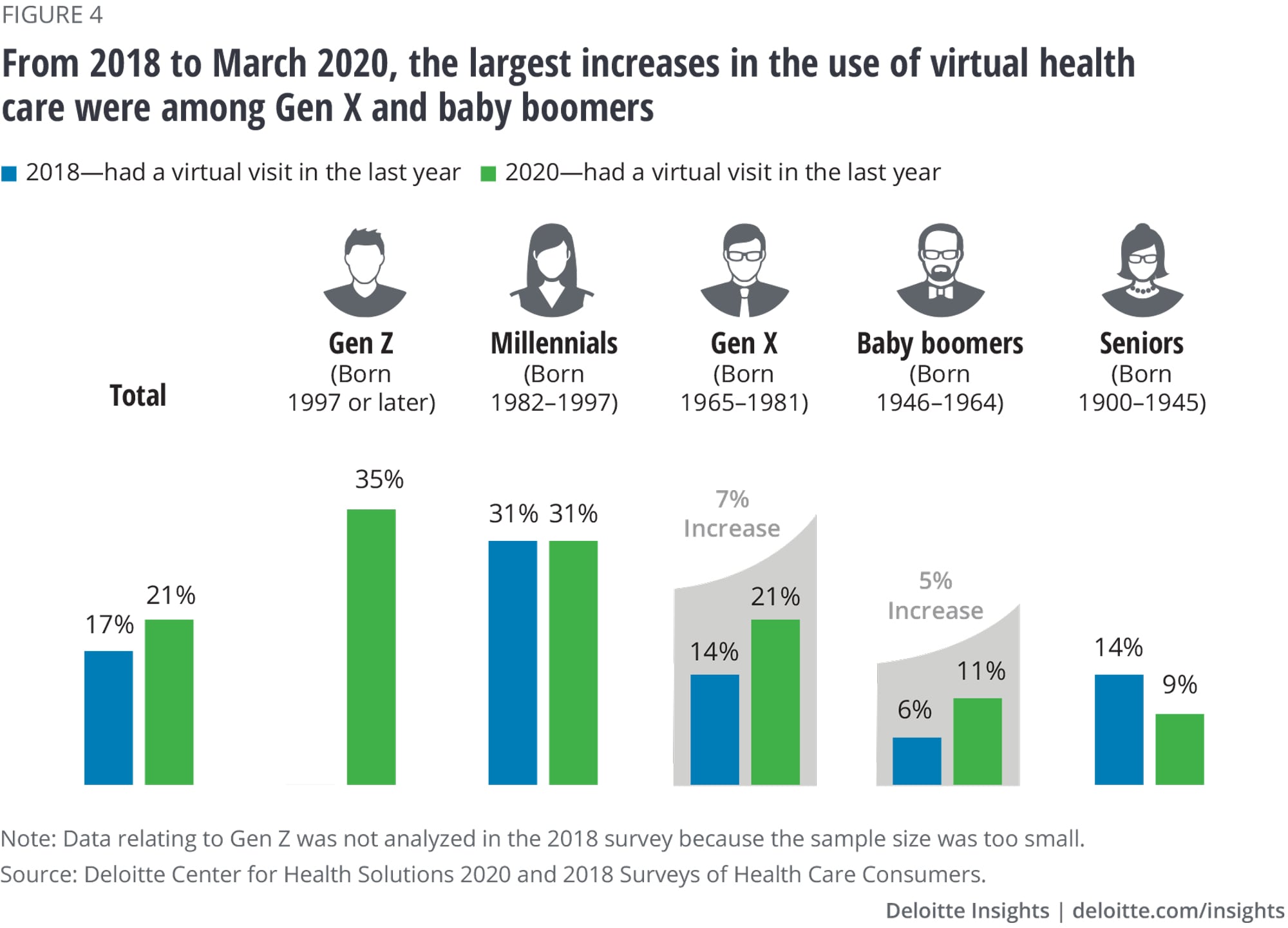
A majority of consumers (80%) who have had a virtual-care visit would choose to have another, particularly, younger people (Gen Z, 86%, and millennials, 83%) and those with a chronic disease, 88%.
The experience of the actual virtual visit is mixed for consumers. For example, more of them said they are getting the Rx and information they need from their virtual visit in 2020 vs 2018 (figure 5). However, consumers are still identifying gaps where virtual visits aren’t meeting their needs. Fewer consumers were happy with their clinician (either comfort or confidence in their knowledge), and wait times appear to be a bigger issue in 2020.
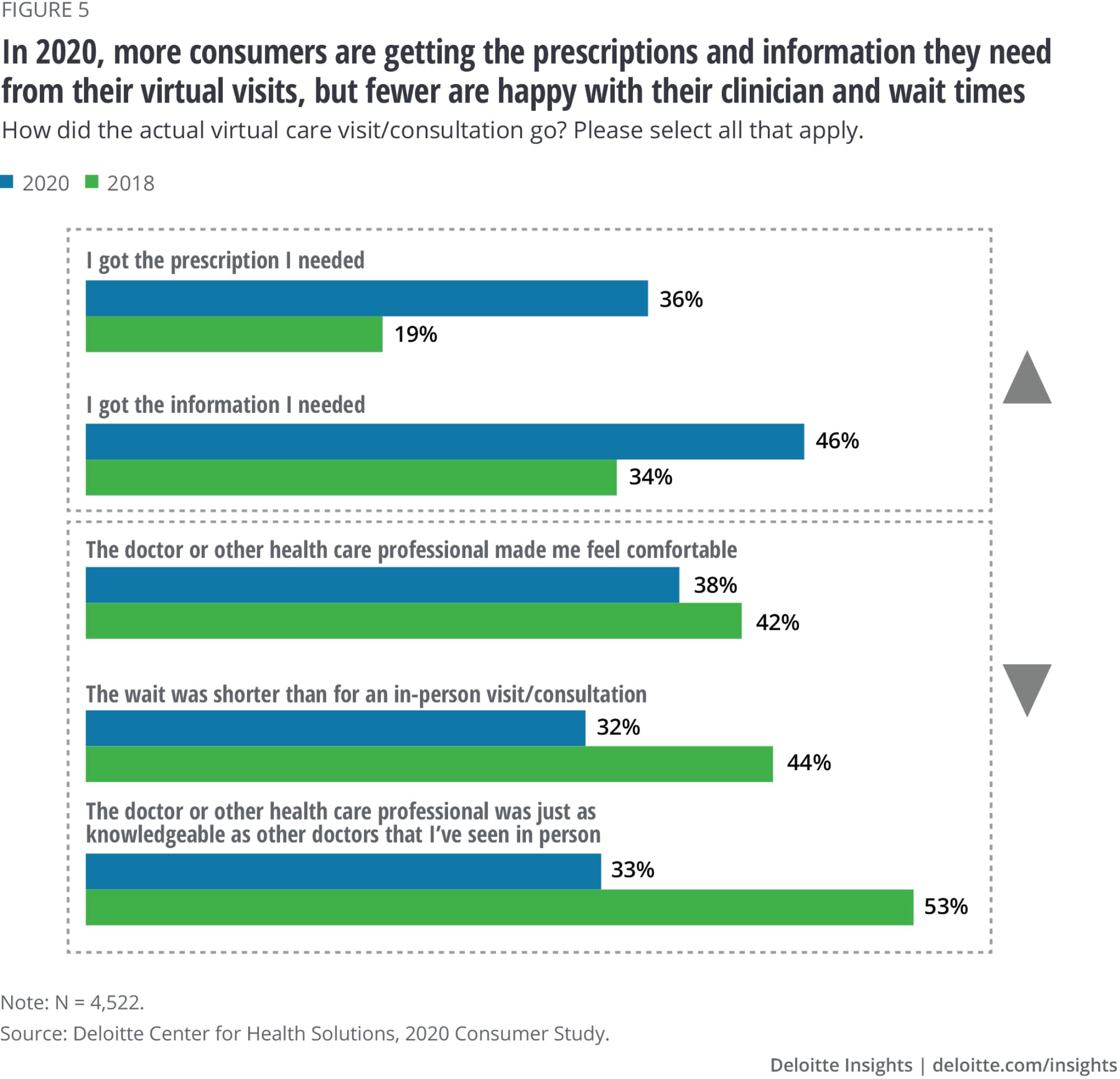
Consumers still want the benefits of in-person health care services—a personalized clinician-patient relationship
As with in-person visits, consumers expect their virtual visits to be of high quality and with clinicians who listen, take their time, and treat them well. The Deloitte 2020 Survey of US Health Care Consumers found that among consumers who wouldn’t have another virtual care visit, a third said that quality of care was not as good as with their regular doctor and one out of five said they did not like the way the clinician treated them.
We also found similar experiences during the pandemic. In the Deloitte April COVID-19 consumer survey, respondents reported holding on to traditional beliefs about the benefits of in-person health care services:
- Sixty-six percent of respondents believe that a doctor or nurse needs to physically examine them to understand their health needs
- Fifty-six percent don’t think they get the same quality of care/value from a virtual visit as from an in-person visit.
In our Deloitte research on consumer experience, we repeatedly found that the health care provider relationship remains the top priority for consumers. In the Deloitte 2020 Survey of US Health Care Consumers the top four factors for “an ideal health care experience” mirrored our findings in a similar study on consumer priorities in 2016.
When asked to rank the most important factors for an ideal experience with their doctor, in 2020, consumers ranked them as follows:
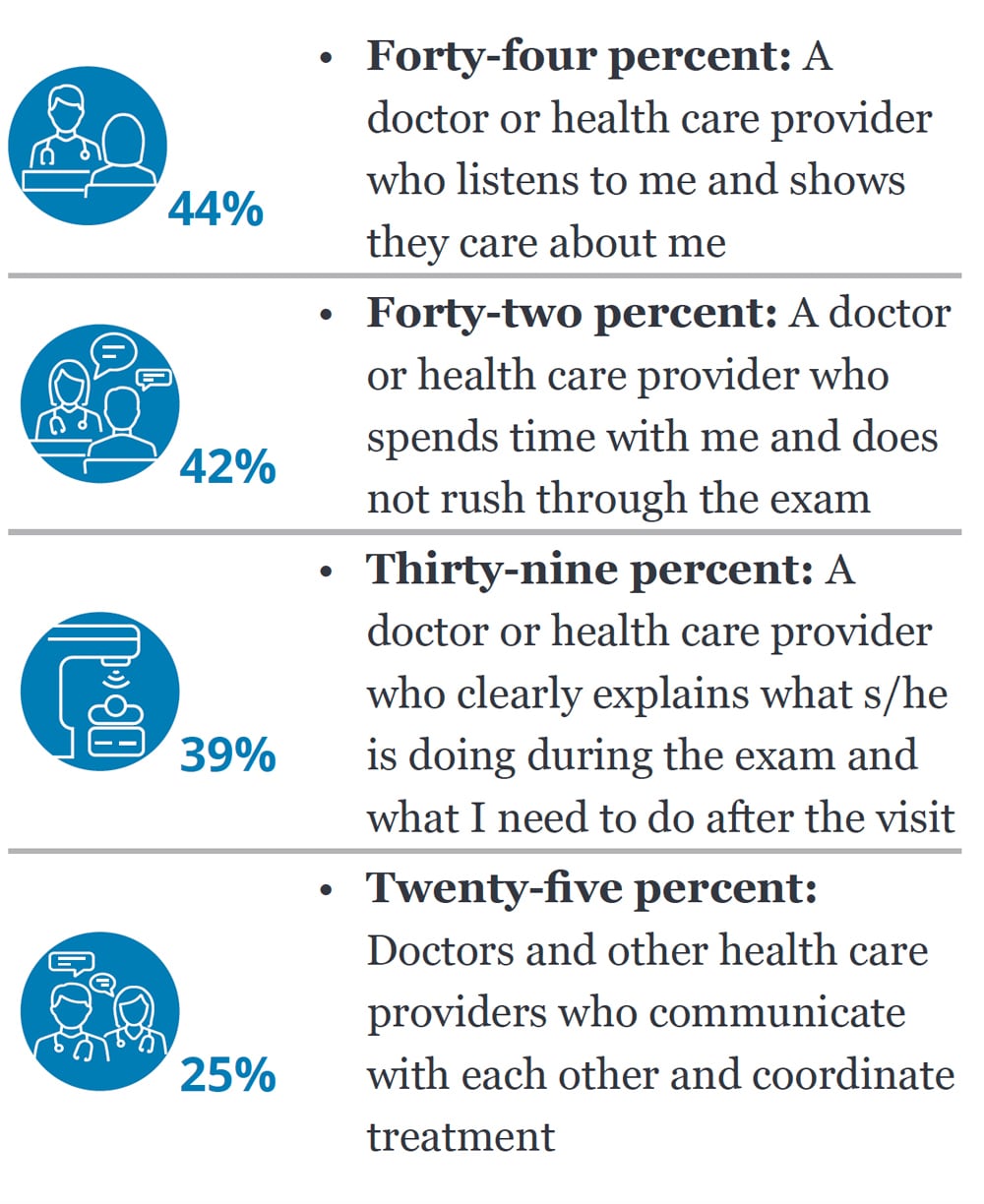
Even as consumers use virtual visits and other nontraditional settings, consumers still expect trusting relationships and pleasant experiences with their clinicians. This is particularly true for people with chronic conditions, as they are most likely to value a sustained relationship.
Health care organizations could improve the virtual visit experience by training their physicians and clinicians. In the 2020 Deloitte Survey of US Physicians, 85% of physicians across the country said that training around improving virtual visit skills such as conveying empathy is essential but absent in their practice.7
After a slight decline in willingness to share data pre-COVID-19, consumers are now more comfortable sharing it
From 2018 to 2020 (pre-pandemic) we saw a decrease in consumers’ willingness to share their data in all the areas we measured, except for health care research, which stayed steady (figure 6). However, during the pandemic, our study showed an increase in consumer willingness to share data in every scenario measured. Note that though questions in the two surveys were not exactly the same, they were similar enough to help us make directional conclusions.
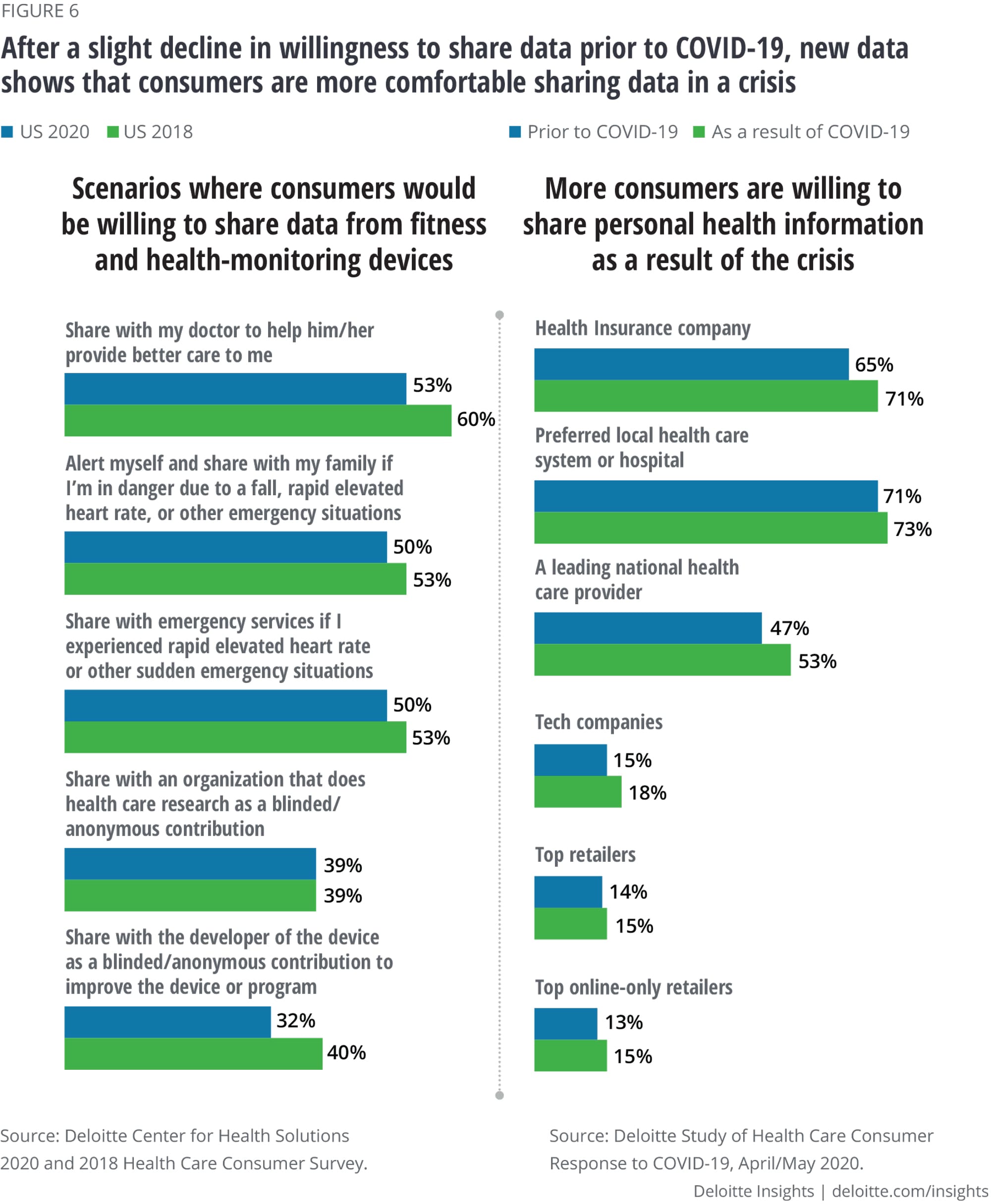
Individuals’ willingness to share data is important for developing the interoperable data platforms necessary to drive innovation/discovery. It can also help clinicians and consumers be more proactive in health management. Health systems and clinicians that decide to work with tracked data should determine how to organize it so that it’s interoperable. Besides, in clinical trials, organizations/researchers should ensure they have patient education, consent, and support systems in place.
Adoption of apps and at-home self-diagnostic and genetic tests is accelerating
At-home tests, mobile devices, and related technologies are enabling new ways to diagnose, monitor, and manage patients and their treatment. Companies are developing these tests and apps along a continuum of wellness and prevention strategies, ranging from acute infection diagnosis and chronic-disease management to identifying future risks of illness.
About a third to half of consumers are comfortable using at-home diagnostics for various reasons (figure 7). Before COVID-19, consumers overall were most comfortable using at-home tests for diagnosing infections. Younger generations were more comfortable across the board. The largest gaps in comfort levels by generation were for genetic tests (24% of seniors vs 47% of Gen Z and millennials) and at-home blood tests to track overall health (28% of seniors vs 47/48% of Gen Z and millennials).
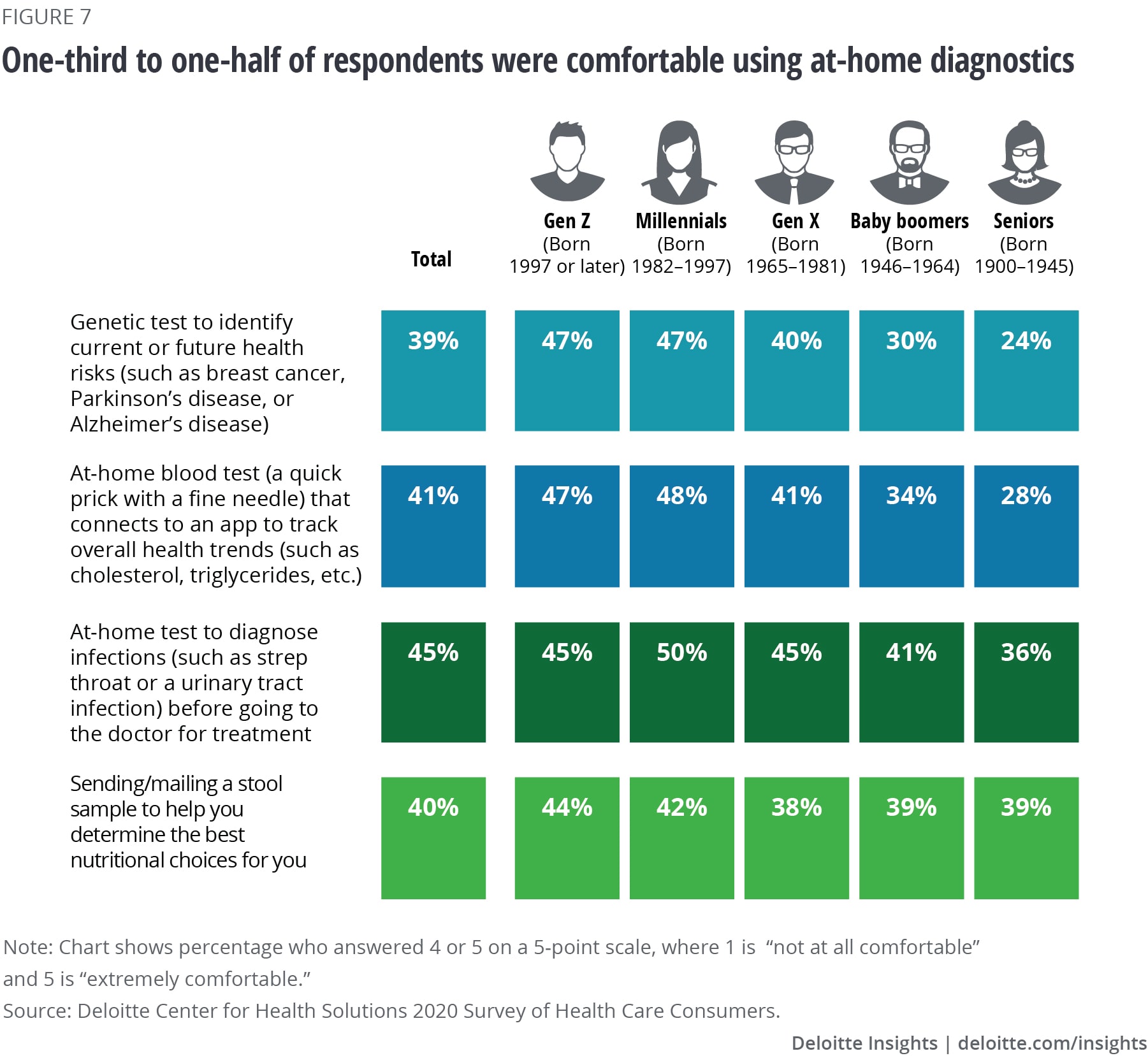
Implications for health care organizations
The health care consumer of the future is arriving faster than anticipated, fueled by the COVID-19 pandemic. Every person’s health journey and experience of the pandemic has been different. Yet, it is fair to say that this period has been and continues to be challenging for everyone. Even though health care organizations themselves have faced challenges, they should recommit themselves to understanding consumers and creating a multifaceted strategy that speaks to where consumers are right now. Health care organizations should tune their services to:
Deploy new tools and services. With health care consumers now more willing to adopt tools and share data and adopt virtual visits, new digital tools can play an important role in the future of care—from monitoring a person’s health, to helping individuals get access to more convenient care, to giving caregivers peace of mind, and helping older adults remain in their homes rather than move to institutional care. When organizations deploy them optimally, these tools have the potential to increase consumer satisfaction, improve medication adherence, and help consumers track and monitor their health (including signs and symptoms that may alert them to the need for care).
Explore ways in which to benefit consumers through data interoperability. While consumers are more willing to share their data, organizations should ensure that the data serves consumer needs—through adequate interoperability. Younger consumers are most likely to say they will use digital tools for their health but are also the most frustrated with the inconvenience of their data spread across various channels. Today, some organizations and developers are working together to give consumers one-stop access to their medical information and control over how the data are shared. But this will likely require interoperability between the various organizations that currently own or store the data.
Invest in virtual health technology and training clinicians in its use. Investing in virtual health technology and facilities can also benefit both consumers and organizations. Improving telehealth capabilities and designing a process whereby consumers can access their own physicians instead of third-party services could help health care organizations streamline and maximize the benefits of virtual health. Our surveys show that while consumers are keen on future virtual visits, it is not just access that matters. They are still not completely satisfied with their interactions with the doctor or clinician. Training these personnel in building virtual interpersonal relationships can be a major step toward improving the virtual visit experience. And while the physicians explore ways in which to improve their virtual interactions, organizations should support them in the sustained use of virtual health, instead of returning to traditional in-person visits to ease the friction.
Create more access points to help improve drivers of health. Social determinants of health are an important factor in improving overall well-being, though they might also be among the most difficult problems to address. However, there is opportunity for health care organizations to address the disparities that exacerbate these issues. For instance, health plans, especially those focused on Medicaid and Dual Eligibles, should consider creating more access points, potentially staffed by care extenders, deep into communities that address the drivers of health, enabling better access to traditional care as well as access to food, educational resources, connections to other social services agencies, and information.
Earn consumer trust through empathy and reliability. Although more consumers are sharing data because of the virus, as the public health crisis calms down, they might not be as willing to share it. Organizations need strategies to build trust to make consumers feel comfortable sharing their personal health data. One strategy is to make clear that consumers own their data. We found that a large majority of consumers (65%) think that they should own their own health data vs 30% who think their doctor should own it, and even fewer who think that the government should own it. In a recent Deloitte survey on human experience, consumers ranked empathy and reliability as the top two factors when seeking out a health care experience. To maintain or even re-earn the trust of consumers, health care organizations should demonstrate reliability, transparency, and, most importantly, a sense of empathy in how they conduct operations moving forward. As consumers consider their options for where they’ll get their care, health care leaders could inspire in them a sense of control that helps reduce uncertainty and enable the right connections to help consumers get the resources they need.
© 2021. See Terms of Use for more information.
More on digital health
-
How the virtual health landscape is shifting in a rapidly changing world Article4 years ago
-
Consumers are on board with virtual health options Article6 years ago
-
The future of virtual health Article4 years ago
-
Forces of change in health care Article5 years ago
-
Health care Collection














